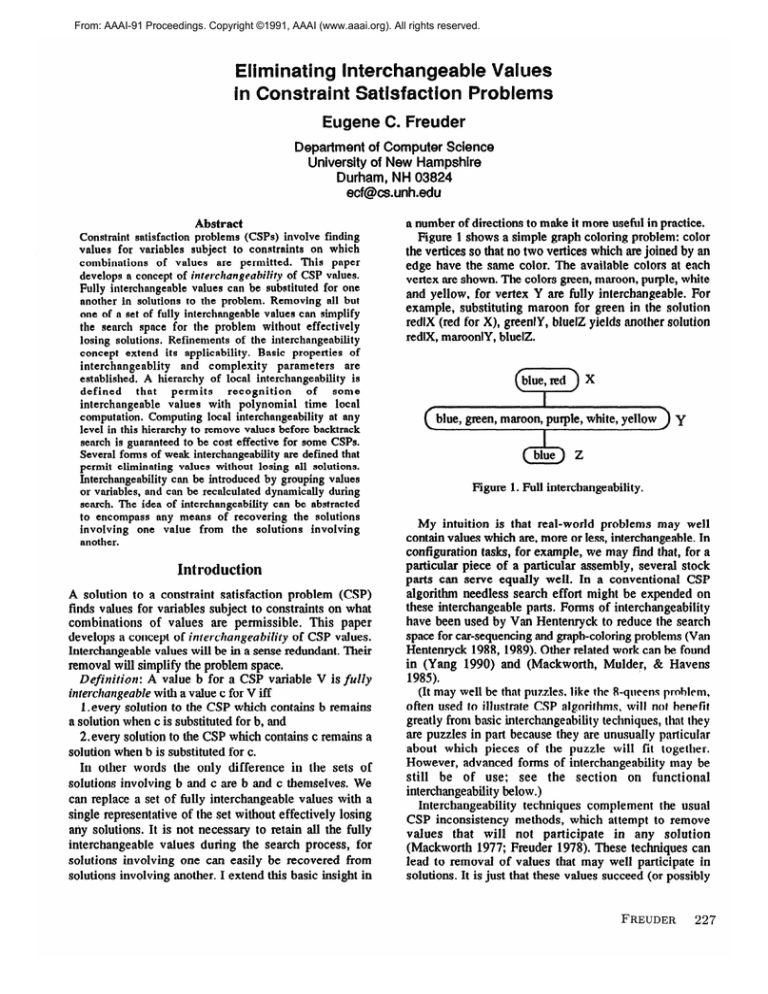
From: AAAI-91 Proceedings. Copyright ©1991, AAAI (www.aaai.org). All rights reserved.
Eugene 6. Freuder
Department of Computer Science
University of New Hampshire
Durham, NH 03824
ecf@cs.unh.edu
Abstract
Constraint satisfaction problems (CSPs) involve finding
values for variables subject to constraints on which
combinations
of values are permitted. This paper
develops a concept of intndrangcability of CSP values.
Fully interchangeable values can be substituted for one
another in solutions to the problem. Removing all but
one of a set of fully interchangeable values can simplify
the search space for the problem without effectively
losing solutions. Refinements of the interchangeability
concept extend its applicability.
Basic properties of
interchangeablity
and complexity
parameters
are
established. A hierarchy of local interchangeability
is
recognition
of
some
defined
that
permits
interchangeable
values with polynomial
time local
computation. Computing local interchangeability at any
level in this hierarchy to remove values before backtrack
search is guaranteed to be cost effective for some CSPs.
Several forms of weak interchangeability are defined that
permit eliminating values without losing all solutions.
Interchangeability can be introduced by grouping values
or variables, and can be recalculated dynamically during
search. The idea of interchangeability can be abstracted
to encompass any means of recovering the solutions
involving
one value from the solutions involving
another.
Introduction
A solution to a constraint satisfaction
problem (CSP)
finds values for variables subject to constraints on what
combinations
of values are permissible.
This paper
develops a concept of interchangeability
of CSP values.
Interchangeable values will be in a sense redundant. Their
removal will simplify the problem space.
Definition:
A value b for a CSP variable V is fully
interchangeable with a value c for V iff
l.every solution to the CSP which contains b remains
a solution when c is substituted for b, and
2.every solution to the CSP which contains c remains a
solution when b is substituted for c.
In other words the only difference
in the sets of
solutions involving b and c are b and c themselves. We
can replace a set of fully interchangeable
values with a
single representative of the set without effectively losing
any solutions. It is not necessary to retain all the fully
interchangeable
values during the search process, for
solutions involving
one can easily be recovered from
solutions involving another. I extend this basic insight in
a number of directions to make it more useful in practice.
Figure 1 shows a simple graph coloring problem: color
the vertices so that no two vertices which are joined by an
edge have the same color. The available colors at each
vertex are shown. The colors green, maroon, purple, white
and yellow, for vertex Y are fully interchangeable.
For
example, substituting
maroon for green in the solution
redlX (red for X), greenly, blue12 yields another sofution
redlX, maroonlY, bluelZ.
Figure 1. Full interchangeability.
My intuition
is that real-world
problems may well
contain values which are, more or less, interchangeable.
In
configuration
tasks, for example, we may find that, for a
particular piece of a particular assembly, several stock
parts can serve equally well. In a conventional
CSP
algorithm needless search effort might be expended on
these interchangeable
parts. Forms of interchangeability
have been used by Van Hentenryck to reduce the search
space for car-sequencing and graph-coloring problems (V,an
Hentenryck 1988, 1989). Other related work can be found
in (Yang 1990) and (Mackworth,
Mulder, & Havens
1985).
(It may well be that puzzles, like the %queens prddem,
often used to illustrate CSP algorithms, will not benefit
greatly from basic interchangeability
techniques, that they
are puzzles in part because they are unusually particular
about which pieces of the puzzle will fit together.
However, advanced forms of interchangeability
may be
still
be of use; see the section
on functional
interchangeability
below.)
Interchangeability
techniques
complement
the usual
CSP inconsistency
methods, which attempt to remove
values
that will not participate
in any solution
(Mackworth 1977; Freuder 1978). These techniques can
lead to removal of values that may well participate in
solutions. It is just that these values succeed (or possibly
FREUDER
227
fail) “equally well”. Tnconsistency can also be viewed as a
special case of interchangeability:
inconsistent values all
participate in the same set of solutions: the empty set.
Removing interchangeable
values complements work on
removing redundant constraints from CSPs (Dechter &
Dechter 1987). Interchangeability
emphasizes what P call
the microstructure of a CSP. The microstructure involves
the pattern of consistency connections between values as
opposed to variables.
Eliminating
interchangeable
values can prune a great
deal of effort from a backtrack search tree. The example of
Figure 1 demonstrates
this on a very small scale: with
variables and values chosen in lexicographic order during
search, eliminating
redundant
interchangeable
values
results in a backtrack search tree with half as many
branches.
If
we
are
seeking
all
solutions,
interchangeability
allows us to find a family of similar
solutions
without
what might otherwise
involve
a
complete duplication
of effort, for each member of the
family. The processing necessary to automate the removal
of interchangeable
values may prove particularly useful in
contexts where constraint networks are used as knowledge
bases subject to multiple
queries,
over which such
preprocessing can be amortized.
For simplicity
I will assume binary CSPs, which
involve only constraints between two variables. However,
interchangeability
clearly applies to non-binary CSPs (and
non-binary
CSPs can be transformed
into binary ones
(Rossi, Dhar, & Petrie 1989)).
Section 2 discusses local forms of interchangeability.
Section
3 provides
means of taking advantage
of
interchangeability
even when such opportunities
are not
strictly or immediately
available.
Along the way I
introduce a new, concrete methodology
for evaluating
CSP search enhancements
with best and worst case
constructions,
and suggest that interchangeability
can
motivate concept formation and problem decomposition.
Local Interchangeability
Completely identifying fully interchangeable values would
seem, in general, to require solving for aU solutions. This
section identifies various forms of local interchangeability
that are more tractable computationally.
Figure 2. Neighborhood
We will say that red and white are neighborhood
interchangeable
values for W. The term “neighborhood” is
not being used simply because it is motivated by the
coloring problem. CSPs are commonly represented
by
constraint graphs, where vertices correspond to variables
and edges-to-constraints.
(Constraint
graphs for graph
coloring problems conveniently,
or confusingly,
- _ have the
same graph structure as the -graph to be colored.) In
general we have the following:
Definition: Two values, a and b, for a CSP variable V,
are neighborhood interchangeable iff for every constraint
c on v:
{ i I (a,i) satisfies C} = { i I (b,i) satisfies C).
Notice that the blue value for W is in fact fully
interchangeable
with red and white, even though it is not
neighborhood interchangeable
with them. The reason for
this is that blue must be chosen for Z, thus cannot be
chosen for X or Y. Thus blue for W will fit into any
complete
solution
that red or white
will.
The
incompatibility
of blue for W with blue for X and Y does
not matter in the end. On the other hand, since red and
white are neighborhood
interchangeable,
there is no way
they could fail to be interchangeable
in any complete
solution: there is no constraint that one could satisfy and
not the other.
More generally we have the following simple theorem:
Theorem
I: Neighborhood
interchangeability
is a
sufficient,
but not a necessary
condition
for full
interchangeability.
To identify neighbotiood
interchangeable values we can
construct discrimination
trees. The leaves of the trees will
be the equivalence classes of neighborhood interchangeable
values. The process relys on a canonical ordering for
variable and value names; without loss of generality we
will assume lexicographic ordering.
geenIX
This
section
defines
a basic
form
of local
interchangeability,
neighborhood
interchangeability.
Neighborhood
interchangeability
is a sufficient, but not
necessary,
condition
for full interchangeability.
All
redundancy induced by neighborhood
interchangeability
can be removed from a CSP in quadratic time.
Consider the coloring problem in Figure 2. Colors red
and white for vertex W are interchangeable
from the point
of view of the immediate neighbors, X and Y. Red and
white are both consistent with any choice for X and Y.
The blue value for W is different, it obviously is not
consistent with a choice of blue for either X or Y.
228
CONSTRAINT-BASED REASONING
interchangeability.
-- yellowlX
-- greenly -- yellnwlY
lb1
‘bluelx
-- geenIX
-- yellowlX
-- bluely -- greedY
-- yehwlY
lr. WI
Figure 3. Discrimination
tree.
Figure 3 shows the discrimination
tree for variable W.
For the blue value we build a branch containing first the
consistent values for X, then the consistent values for Y.
We do the same for the red value. As we start at the root
to build the branch for the white value, we see that the
first consistent value, blue for X, is already present as one
of the children,
so we move down to it. We keep
following preexisting branches as long as we can; in this
case, we follow one all the way to the end, and red and
white are found to be equivalent.
Neighborhood Interchangeability Algorithm:
Finds neighborhood interchangeable
values in a CSP.
Repeat for each variable:
Build a discrimination tree by:
Repeat for each value, v:
Repeat for each neighboring variable W:
Repeat for each value w consistent with v:
Move to if present, construct if not, a node of
the discrimination tree corresponding to wlW
A complexity bound for this algorithm can be found by
assigning a worst case bound to each repeat loop. Given n
variables, at most d values for a variable, we have the
bound (the factors correspond to the repeat loops in topdown order):
Q(n * d * (n-l) * d) = O(n2d2)
While this algorithm
will find all neighborhood
interchangeable
values exhaustively,
a practitioner might
observe some interchangeabilities
informally.
Semantic
groupings can help suggest where to look. For example,
in Figure 4, we see a variation on the coloring problem,
where the allowable color combinations, e.g. red for X and
orange for Y, are indicated by links. (Note that this is
unlike the usual constraint
graph convention
where
constraint graph edges represent entire constraints. We are
representing the microstructure of the problem here: each
link joins an allowable pair of values.) Red and orange are
interchangeable,
for both X and Y, as are blue and green.
Semantic knowledge
of the “warm” and “cool” color
might
suggest
looking
for
such
concepts
interchangeability.
X
Y
Figure 4. Semantic
interchangeability.
On the other hand it might be interesting to view the
grouping
by an interchangeability
algorithm
into
equivalence classes of red and orange, blue and green, as a
concept formation process. The “functional” semantics
inherent in the underlying problem (perhaps a problem in
decoration
or design) motivates creation of classes of
colors, corresponding
to the conventional
concepts of
warm and cool.
K-interchangeability
This section introduces
through a concept called k-interchangeability.
Kinterchangeability
involves CSP subproblems.
For our
purposes a subproblem of a CSP will consist of a subset
S of the CSP variables along with all the constraints
among them, call this the subproblem induced by S.
Definition: Two values, a and b, for a CSP variable V,
are k-interchangeable
iff a and b are fully interchangeable
in any subproblem of the CSP induced by V and k-l other
variables.
Observe that 2-interchangeability
is equivalent
to
neighborhood interchangeability.
(Values will be trivially
interchangeable
in a subproblem if there are in fact no
constraints
in the subproblem.)
For a problem with n
variables,
n-interchangeability
is equivalent
to full
interchangeability.
(A set is, of course, a subset of itself.)
The term local interchangeability
will be used to refer to
k-interchangeability
for ken.
The theorem of the previous section generalizes:
Theorem 2. For icj, i-interchangeability
is a sufficient,
but not necessary condition for j-interchangeability.
In
particular,
any level of local interchangeability
is
sufficient to ensure full interchangeability.
Proof. As the level of interchangeability
increases we
can only increase the size of the interchangeability
equivalence classes.
A solution to a subproblem
may fail to be part of a
solution to a larger subproblem, removing an impediment
to interchangeability
as k increases. Thus the condition is
not a necessary one.
It is sufficient, however. Suppose a and b, values for V,
are i-interchangeable.
I claim they are j-interchangeable.
Suppose not. Then there is a j-tuple subproblem solution
where substituting a for b (or vice versa) fails to produce
another solution.
The failure involves
at least one
constraint, between V and another variable, say U. Throw
away j-i elements of the j-tuple solution, but make sure
you keep the values for V and U. You now have a
solution to an i-tuple of variables where substituting a for
b (or vice versa) fails to produce another solution. This
contradicts the assumed i-interchangeability.
QED.
The algorithm for finding neighborhood interchangeable
values generalizes
to an algorithm
for finding
kinterchangeability.
The assumed ordering of the variables
and values induces a canonical ordering of variable and
value tuples. Each entry in the discrimination
net is now a
(k-l)-tuple of values.
K-l~ztercltangeabilit?! Algorithm:
Finds k-interchangeable
values in a CSP.
Repeat for each variable:
Build a discrimination tree by:
Repeat for each value, v:
Repeat for each (k-1)-tuple of variables
Repeat for each (k-1)-tuple of values w, which
together with v constitute a solution to the
subproblem induced by W:
NIove to if present, construct if not, a node of
the discrimination tree corresponding to wlW
levels of local interchangeability
FREUDER
229
O(n * d * nksl * dk-‘) = O(nkdk).
The algorithm includes a brute force search for all the
solutions of each subproblem.
Performance
might be
improved by carrying out these searchs more efficiently in
Theorem 3. For any number of variables ~2, any
ken, and any computation
cost C, there exist CSPs for
which the cost of solving by backtrack search exceeds by
more than C the cost of solving by k-interchangeability
preprocessing
followed by backtrack search. This is true
regardless of whether we take “solving” to mean finding a
single solution, finding all solutions or finding that there
is no solution.
Proof.
For each interpretation
of “solving”
I
demonstrate that I can construct CSPs with the desired
property. I show that the best results we can hope for on
those CSPs without preprocessing is worse, by at least C,
than the worst behavior we can expect with preprocessing.
For simplicity assume that a constructed CSP will have
the same number of values, d, for each variable. Assume
that backtrack search instantiates variables and chooses
values according to their lexicographic ordering.
Consider first the case where there is no solution:
We construct
a CSP where failure occurs during
backtrack search only when instantiating the last variable,
V, and conducting
the last consistency
check, against
variable U. IBacktrack search will thus need to examine the
advance. On the other hand O(nkdk) seems likely to be an
optimal worst case bound for finding all the subproblem
solutions.
Since it is hard to imagine
how all kinterchangeable
values could be identified
without
complete search
the search tree.
there is really
constraint check
space tree. There will be d” branches in
Since between most pairs of variables
no constraint,
I will only count one
per branch. The effort for backtrack search
completely solving all these subproblems, O(nkdk) seems
likely
to be a tight worst
case bound
for this
identification.
Once the equivalence
classes
of kinterchangeable
values are identified one representative of
each class can be retained and the rest of the class declared
redundant
and removed (within the same time bound
obviously).
Despite this potentially
costly worst case behavior, I
claim that removing redundant interchangeable
values can
yield great savings in some cases. Furthermore this is true
even for large k. For any ken there are problems for
which
preprocessing
to remove
redundant
kinterchangeable
values before backtracking
will be cost
effective.
In fact for any ken, k-interchangeability
preprocessing
is arbitrarily
effective in the sense that
whatever savings you specify, I can find a CSP for which
k-interchangeability
preprocessing
saves that amount of
effort.
The basic
observation
is that eliminating
an
interchangeable
value prunes the subtree below that value
in the backtrack search tree. If all values of a single
variable
are found to be interchangeable,
we have
effectively eliminated a level of the backtrack tree; we are
is then c ldn+c2,
for appropriate
Complexity
Analysis
This section is concerned with local interchangeability
complexity
issues. A complexity
bound for the kinterchangeability
algorithm is obtained, O(nkdk), where d
is the maximum
number of values (the size of the
domain) for any variable. There is reason to believe that
this is an optimal upper bound. I prove that for any level
of local interchangeability
there are cases in which
preprocessing
to remove redundant
k-interchangeable
values
before
backtracking,
k-interchangeability
preprocedng,
will be cost effective.
The complexity
analysis of the k-interchangeability
algorithm
is similar
to that
for neighborhood
interchangeability,
allowing
I)-tuples of variables
get a bound:
left with a maximum
for a worst case O(nk-‘)
and dk’l (k-1)-tuples
of d”-l
,
of values, we
search tree branches,
than d”. If all values of i variables
(k-
are interchangeable
rather
the
search tree has at most dnwi branches. If all values of all
variables
are found to be interchangeable,
we are
effectively done (anything is a solution). If all values of
one variable are interchangeable
and they all participate in
no solutions,
we are effectively
done (there is no
solution).
230
CONSTRAINT-BASED REASONING
constants
cl and c2.
Substituting
n- 1 into the k-interchangeability
bound,
we obtain a worst case effort for interchangeability
preprocessing
of c3n n-1dn-1+c4,
c3 and ~4.
The
algorithm
for appropriate
which
identifies
constants
(n- l)-
interchangeability
will discover,
and can be trivially
altered to report, that all the values of V fail to participate
in any solutions to subproblems
involving
U. This is
sufficient to determine
that the CSP has no solution,
without any subsequent backtrack search.
Now the question is can it be true that:
cld”+cz
> c3n n-1dn-1+c4
+C ?
Simple algebra tells us that this will be true if:
d >
for appropriate
Cal-+
constants
+ c6
cs and c6. In other words, we
only need construct a problem where the number of values
is sufficiently
large in comparison
with the number of
variables.
(The nature of “sufficiently
large” may be offputting,
but bear in mind this is a worst case scenario
for
interchangeability
involving (n- I)-interchangeability.
Also
observe that there are simple cases with 2 variables and 3
values that demonstrate
the desirability
of even (n-l)interchangeability
preprocessing.)
Now consider the case where we search for a single
solution:
The construction is similar. This time the last variable
in the search
tree,
V, will
be such
that k-
interchangeability
preprocessing reduces the domain of V
to a single value. This value will only be consistent with
the last value, in the ordering of values, for each other
variable. Thus there will be a single solution, which will
appear as the “rightmost” branch of the search tree. Again
all pairs of values between variables other than V are
consistent. We have at most d”-’ branches in the search
tree. (Actually interchangeability
redundancy
removal
should prune the search tree further.) For each branch there
are n-l non-trivial constraints to check, those between V
and the other n-l variables. Thus the backtrack search
effort, after preprocessing reduces the number of variables
for V to one, is at most:
cl(n-l)dn1+c2.
Adding
the effort
for (n-I)-interchangeability
preprocessing we have a total effort of:
+ (c3n n-1dn-1+c4).
(cl(n-l)dn-‘+c2)
Without preprocessing the search tree will have d”-(d-l)
branches. Search will repeatedly try all d values for V,
until success is achieved with the last value for every
other variable. Thus search effort will be:
c5(n-l)(d”-(d-l))%6
We want:
(c,(n-l)dn1+c2)+(c3n
n-1dn-1+c4)
c Cs(n- l)(d”-(d- 1))+C@C.
Simplifying,
it is sufficient
that:
d>c7nn-‘+c
for appropriate constants
8
c7 and cg.
Finally, consider the case where we are looking for all
solutions:
This time construct a CSP where k-interchangeability
reduces a variable V to a single value and that variable is
the first variable to be instantiated in the backtrack search
order. Consider the final variable, W. Arrange that only
the final value for W is consistent with anything, and it is
only consistent with the final value for each of the other
variables (with the exception of V; it is consistent with
all values of V). Other pairs of values are all consistent.
Thus backtrack search will check out dn-1 branches before
finding
the first solution.
Backtrack
search after
interchangeability
preprocessing
will require if anything
less effort to reach the first solution (interchangeability
can reduce the number of values for other variables). Once
the first solution
has been found interchangeability
preprocessing
will permit simply substituting
to obtain
the other d-l solutions, while backtrack search requires
searching another size d n-l search tree for each additional
solution. Clearly, for sufficiently large d, the savings here
can be as large as we like. Q.E.D.
Observe that the constructions in the proof work for any
level of k-interchangeability,
including the lowest. If 2consistency, for example, is sufficient to create a situation
like those constructed above. the savings can be dramatic,
even without an inflated value for d, and not just for
finding multiple solutions. It may be that the potential
payoff fro
relatively inexpensive %nterch,angeabihty
preproces
or the potential cost of doing without it-will
motivate
routine
preprocessing
for
2interchangeability.
Theorem 4: For any n>2 and any d, there exist CSPs
with n variables and d values for each, for which the
savings achieved by preprocessing for 2-interchangeability
is O(n2dn) .
Proof. Construct a CSP with no solution where none of
the values for one variable, V, are consistent with any
value for one of the others, U, while all other value pairs
are permitted. 2-interchangeability
will discover that there
is no solution with O(d2n2) effort. Assume a search order
where U is the first variable to be instantiated and V the
last. This will require a full backtrack tree search with
O(n2dn) effort .
e difference is O(n2dn) . Q *.
E D.
Observe further that the cost ‘of (n- 1 )-interch,angeability
preprocessing
is such that the arguments in Theorem 3
focused not on how easily we could proceed with the
search after removing redundant values, but on ensuring
that backtrack search without preprocessing would require
a sufficiently large effort. The calculations did not take
into account that interchangeability
can affect more than a
single
variable.
Even
2-interchangeability
can
significantly reduce the number of values for many of the
variables (in the extreme down to a single value for each
variable) resulting in a major savings in the effort required
to find one, or all, solutions.
Note that very similar arguments
to those in this
section should produce similar results regarding
the
efficacy
of k-consistency
preprocessing.
Indeed
constructions
in this section are reminiscent of the basic
“thrashing” arguments that long ago pointed out problems
with
conventional
backtrack
search,
motivating
consistency “relaxation” preprocessing techniques among
other refinements (Bobrow & Raphael 1974). However, I
do not believe that this kind of concrete analysis has been
carried out previously for thrashing type behavior.
This section provides means of taking advantage of
interchangeability
even when such opportunities
are not
strictly or immediately available.
This
section
defines
several
forms
of ~‘4 a k
interchangeability.
These may involve sacrificing some
solutions, but this will not matter if we are seeking a
single solution.
Locally computable
forms of these
concepts are available.
ity.
The simplest
form
of weak
interchangability
is substitutability;
this captures the idea
that interchangeability
can be restricted to a “one-way”
FREUDER
231
concept.
Definition:
Given two values, a and b, for a CSP
for b iff substituting
a in
variable V, a is substitutable
any solution involving b yields another solution.
We can remove b from the problem, knowing that we
have not removed all the solutions.
If there was any
solution involving b, there will remain a solution where a
is substituted for b. However we cannot recover solutions
involving b by substituting
b in the solutions involving
a, as we do not know which, if any, of those substitutions
produce solutions,
If each of two values can be substituted for the other,
the two values are fully interchangeable.
Substitutability
can be computed locally. In particular, we have:
Definition: For two values, a and b, for a CSP variable
V, a is neighborhood
substitutab&e for b iff for every
constraint C on V:
{ i I (a,i) satisfies C } r, { i I (b,i) satisfies C }.
In the example
of Figure 2, red is neighborhood
substitutable for blue for variable W, even though red and
blue are not neighborhood interchangeable.
Partial Interchangeability.
Partial interchangeability
captures the idea that values for variables may “differ”
among themselves,
but be fully interchangeable
with
respect to the rest of the world.
Definition: Two values zue partially interchangeable,
with respect to a subset S of variables, iff any solution
involving
one implies a solution
involving
the other
with possibly different values for S.
When S is the empty set, the values
are fully
interchangeable.
Figure 5 presents an example of partial
interchangeability:
blue and red for W are partially
interchangeable,
with respect to the set (X}. Note: blue
and red for W are interchangeable as far as V is concerned;
blue for W goes with red for X, and red for W with blue
for X; blue and red for X are interchangeable
as far as Y
and 2 are concerned. Thus while substituting say red for
blue in a solution for W necessitates a change in the value
for X, it will not require any change in the values for V,
Y or Z.
rohkm
Interchangeability.
Subproblem
interchangeability
captures the idea that values can be
interchangeable
within
a subproblem
of the CSP.
Subproblem interchangeability
may motivate and guide a
divide and conquer decomposition of a CSP.
Definition:
Two
values
are subproblem
with respect to a subset of variables S,
interchangeable,
iff they are fully interchangeable
with regards to the
solutions of the subproblem of the CSP induced by S.
Note the values are required to be fully interchangeable
with regard to the subproblem, not the complete CSP. Of
course, when S is the entire set of variables,
the
subproblem is the complete CSP, and the values are fully
interchangeable
for
the
CSP.
Subproblem
interchangeability
and partial interchangeability
are not
quite inverse notions.
Theorem
5: Subproblem
interchangeability
with
respect to S implies partial interchangeability
with respect
to S’, the variables
not in S; however,
partial
interchangeability
with respect to S does not imply
subproblem interchangeability
with respect to S’.
Proof: The key observation
is that a solution to a
subproblem
may fail to appear as a portion of any
solution to the complete problem. On the other hand if we
take from a solution to the complete CSP the values for a
subset of variables, those values will constitute a solution
to the subproblem induced by those variab1es.Q.E.D.
By grouping variables into “metavariables”, or values into
“metavalues”,
we can introduce interchangeability
into
higher level “metaproblem” representations of the original
CSP. Meta-interchangeability
might also be viewed as
providing
motivation
and guidance for dividing
CSP
variables into subproblems
and CSP values into concept
hierarchies (Mackworth, Mulder, & Havens 1985).
Figure 6 presents an example of metavalue grouping.
As in Figure 4 we indicate the allowable pairs of values in
the original
CSP with links, e.g. yellow for Y is
consistent with light blue and light red for X. In the
original
problem
yellow and brown for Y are not
interchangeable.
However, if we were to combine sky,
light and dark blue into a metavalue “blue”, and similarly
create the metavalue “red”, we would have a problem in
which yellow and brown are fully interchangeable.
X
( yellow
Figure 5. Partial interchangeability.
brown
black )
Y
Figure 6. Meta-interchangeability.
232
CONSTRAINT-BASED REASONING
We can also merge variables into metavarinbles.
The
values of a metavariable
will be the solutions of the
subproblem induced by the individual variables. Values for
two metavariables
will be consistent if the component
values for the original
variables
are all consistent.
Forming
the’ metaproblem
create
new
may
interchangeabilities.
Dynamic
Interchangea
Interchangeability
can be recalculated
after choices are
made for variable values during backtrack search. It can be
recalculated after inconsistent values have been filtered out
during the search process in a preprocessing step or by a
“hybrid” algorithm
that interleaves
backtracking
and
relaxation. Interchangeability
can also be recalculated to
reflect changes in a dynamic constraint representation.
Interchangeability
might be sought dynamically during a
knowledge acquisition or problem deftition
process.
The idea of integrating
local interchangeability
recalculations
with backtrack
search is especially
intriguing
given the success
of local consistency
calculations in enhancing backtrack search performance.
such that no two attack one another. where rows
correspond
to variables and columns to values. The
reduction
of the values in the first row suggested in
(Reingold, Nievergelt, & Deo 1977) can be viewed as an
application of isomorphic interchangeability.
First observe that the column 1 position for the queen
in the first row is isomorphically interchangeable
with the
column 8 position, the 2 position with the 7 position,
etc. The interchangeability
function f maps position i into
position 9-i, for each row, simulating flipping the board
about its vertical
axis of symmetry.
This permits
eliminating positions 5 through 8 for the first row. Next
observe that because of symmetry about the diagonal axes
position 1 of row 1 is isomorphically
interchangeable
with position 8 of row 8, thus we can eliminate position
1 for the first row.
ents. This material is based upon work
supported by the National Science Foundation under Gr‘ant
No. IRI-8913040. The Government has certain rights in
this material. The author is currently a Visiting Scientist
at the MIT Artificial Intelligence Laboratory.
eferences
The essential idea of interchangeability
is that given the
solutions
involving
one value, we can recover the
solutions involving another. We have been using simple
substitution
to go from one set of solutions to another.
However, substitution
is only the simplest function we
could use.
Definition: Let SvIv be the set of solutions inclusing
value v for variable V. CSP values a for V and b for W
are functionally
interchangeable
iff there exist functions
fa and fb such that fa(SalV) = SblW and fb(SblW) = &IV.
(V and W may be the same variable.)
This is a very general definition that deserves further
study. The definition does not even require that a and b be
values for the same variable. In fact, strictly speaking, any
two values are functionally interchangeable;
once we have
all the solutions we can give a “brute force” definition of
the necessary functions.
The key obviously
is for the
functions to be a priori available or cost effective to
obtain.
One natural refinement
of the definition
involves a
solution preserving function on variable values:
Definition:
Two values, a and 6, for a CSP variable,
are isomorphically
interchangeable
iff there exists a 1-I
function f such that:
l.b=f(a)
2. for any solution S involving
a, { f(v) I v E S } is a
solution
(Bobrow
& Raphael
1974) New programming
languages
for artificial intelligence
research. Compu t.
SW-V. 6,3, 153-174.
(Dechter & Dechter 1987) Removing redundancies
in
constraint networks. Proc. AAAI-87, 1OS- 109.
(Freuder 1978) Synthesizing
constraint expressions.
Commun. ACM 21,1 I, 958-966.
(Mackworth
1977) Consistency
in networks
of
relations. Artzf. Intd. 8, 99-l 18.
(Mackworth, Mulder, & Havens 1985) Hierarchical arc
consistency:
exploiting structured domains in constraint
satisfaction problems. Comput. Intell. 1, 118- 126.
(Reingold, Nievergelt,
& Deo 1977) Corn bina torial
Algorithms. Prentice-Hall.
(Rossi, Dhar, & Petrie 1989) On the equivalence
of
constraint satisfaction problems. MCC Technical Report
ACT-m-222-89.
MCC, Austin, Texas 78759.
(Van Hentenryck
1988) Solving the car-sequencing
problem in constraint logic programming,
Proc. ECAI88.
(Van Hentenryck
1989) A logic
language
for
combinatorial
optimization,
Annals
of Operations
Research 21, 247-274.
(Yang
1990) An algebraic
approach
to conflict
resolution in planning. Proc. AAAZ-YO, 40-45.
3. for any solution S involving b, {f’(v) I v E S } is a
solution.
Problem symmetry is a likely source of this sort of
transformational
interchangeability.
Consider the 8-queens
problem, for example, placing 8 queens on a chessboard
FREUDER
233








